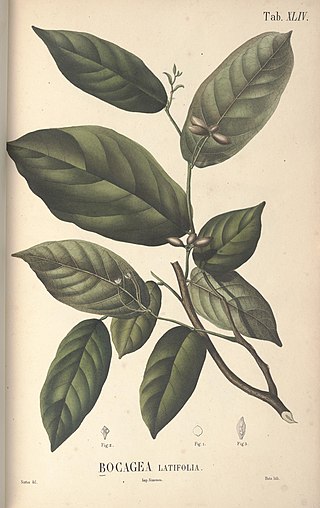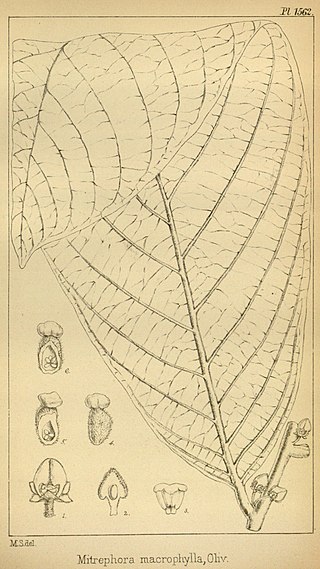Pseuduvaria galeata is a species of plant in the family Annonaceae. It is a tree endemic to Peninsular Malaysia. James Sinclair, the Scottish botanist who first formally described the species, named it after the dome formed by inner petals shaped like a helmet.
Pseuduvaria taipingensis is a species of plant in the family Annonaceae. It is a tree endemic to Peninsular Malaysia. James Sinclair, the Scottish botanist who first formally described the species, named it after Taiping a city in Perak, Malaysia where the specimen he examined was collected.
Pseuduvaria fragrans is a species of plant in the family Annonaceae. It is native to Thailand. Yvonne Su, Tanawat Chaowasku and Richard Saunders the botanists who first formally described the species, named it after its strongly fragrant flowers.

Pseuduvaria glabrescens is a species of plant in the family Annonaceae. It is native to Australia. L.W. Jessup, the botanist who first formally described the species using the synonym Pseuduvaria mulgraveana var. glabrescens, named it after the underside of its leaves which have the quality of becoming hairless as they mature.
Pseuduvaria glossopetala is a species of plant in the family Annonaceae. It is native to the Malay Peninsula. Yvonne Chuan Fang Su and Richard M.K. Saunders, the botanists who first formally described the species, named it after the tongue shaped gland on their inner petals.
Pseuduvaria hylandii is a species of plant in the family Annonaceae. It is native to Australia. L.W. Jessup, the botanists who first formally described the species, named it after Bernard Hyland an Australian botanist who collected the specimen he examined.

Pseuduvaria latifolia is a species of plant in the family Annonaceae. It is native to Java. Carl Ludwig Blume, the German botanists who first formally described the species using the synonym Bocagea latifolia, named it after its broad leaves.

Pseuduvaria macrocarpa is a species of plant in the family Annonaceae. It is native to The Maluku Islands and New Guinea. William Burck, the Dutch botanist who first formally described the species using the synonym Meiogyne macrocarpa, named it after its large fruit.

Pseuduvaria macrophylla is a species of plant in the family Annonaceae. It is native to Peninsular Malaysia, Sumatra and Thailand. Daniel Oliver, the English botanists who first formally described the species using the synonym Mitrephora macrophylla, named it after its large leaves.

Pseuduvaria megalopus is a species of plant in the family Annonaceae. It is native to New Guinea. Karl Schumann, the German botanist who first formally described the species using the synonym Petalolophus megalopus, named it after the large wings that extend downwards from the underside of the inner petals to form a foot of dark red tissue that resembles carrion and is thought to attract fly pollinators.
Pseuduvaria mindorensis is a species of plant in the family Annonaceae. It is native to the Philippines. Yvonne Su and Richard Saunders, the botanists who first formally described the species, named it after the island of Mindoro where the specimen they examined was collected in the municipality of Puerto Galera.
Pseuduvaria mulgraveana is a species of plant in the family Annonaceae. It is native to Australia. L.W. Jessup, the botanist who first formally described the species, named it after the Mulgrave River in Goldsborough, Queensland where the specimen he examined was collected.
Pseuduvaria guineensis is a species of plant in the family Annonaceae. It is native to New Guinea. James Sinclair, the Scottish botanist who first formally described the species, named it after New Guinea where the specimen he examined was collected near Kokoda.
Pseuduvaria obliqua is a species of plant in the family Annonaceae. It is native to Borneo. Yvonne Su and Richard Saunders, the botanists who first formally described the species, named it after its slightly uneven leaf bases.
Pseuduvaria oxycarpa is a species of plant in the family Annonaceae. It is native to Sulawesi. Sijfert Hendrik Koorders, the Dutch botanist who first formally described the species, named it after the pointed tips of its fruit.
Pseuduvaria parvipetala is a species of plant in the family Annonaceae. It is native to Borneo and Sumatra. Yvonne Su and Richard Saunders, the botanists who first formally described the species, named it after its small petals.

Pseuduvaria reticulata is a species of plant in the family Annonaceae. It is native to Bangladesh, Borneo, Java, the Lesser Sunda Islands, Myanmar and Sumatra. Carl Ludwig Blume, the botanist who first formally described the species under the basionym Uvaria reticulata, named it after the net-like pattern of veins on the underside of its leaves.
Pseuduvaria sessilifolia is a species of plant in the family Annonaceae. It is native to New Guinea. James Sinclair, the botanist who first formally described the species, named it after its stalkless leaves which lack petioles.
Pseuduvaria silvestris is a species of plant in the family Annonaceae. It is native to New Guinea. Ludwig Diels, the botanist who first formally described the species under the basionym Orophea silvestris, named it after the forested habitat the specimens he examined were found growing in near the Waria River.
Pseuduvaria unguiculata is a species of plant in the family Annonaceae. It is endemic to The Philippines. Adolph Daniel Edward Elmer, the American botanist who first formally described the species, named it after its clawed inner petals.





